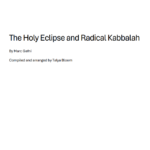Purim and the Carnival of Alternative Selves
by Marc Gafni
Things are rarely what they seem,
Skim milk masquerades as Cream
–W. S. Gilbert, H.M.S. Pinafore
According to the Kabbalah, Purim is an explosive time of paradigm shift and radical change.
We all have a Purim dimension to our personal stories. The trick is to listen deeply and transform what may appear to be the fate of the lottery into the destiny of the soul. It is in times of intense vulnerability that hierarchies, false identities, pompous poses and the external garb of status and station are cast aside. A paradoxical moment of grace is born only from the encounter with radical vulnerability. The ossified conceptions of self are shaken up. We promise ourselves that “if only” we survive the threat, we will be different in very essential sorts of ways. We promise that we will be to our own selves true. We swear an oath to authenticity. However, as we all know too well, once the threat fades we revert very quickly–like a rubber band snapping back into place–to our old tired forms.
The goal of the Purim carnival is to re-access the transformative energy of the very first Purim, when the fixities were loosened and anything was possible. This biblical myth carnival is designed to foster opportunities to recapture the explosive energy set free when old identities crumble, and all is open to question, and all is up for change.
The central rule for the Purim Carnival: drink until you don’t know the difference between Haman and Mordechai. The point of this injunction is not just to leave you with a hangover in the morning; it is to allow you to escape from the strict black and white lines of definition, from the narrow straits of certain identification. Drink until you’ve blurred the lines between the heroes and the villains. For this state of suspension of judgment is crucial for growth and new identity formation – in small doses of course…like once a year.
Bakhtin, the great Russian writer who attempted to resist the evils of Stalinism, captured the existential essence of carnival when he wrote:
“The carnival involves the suspension of all hierarchical precedents. Rank, especially evident at official feasts…was absent at the carnival. At official feasts…Everyone was expected to appear in the full regalia of his calling, rank, and merits, to take the place corresponding to his position. Official feast thus is a consecration of inequality. The carnival undermines the official feast. During the carnival, all were considered equal. In the town square a special form of free and familiar contact reigned among people whom do the barriers of caste, property, profession, and age usually divide. The hierarchical background in the extreme corporative and caste divisions of the medieval social order were exceptionally strong. Therefore, such free familiar contacts were deeply felt and formed an element of the carnival spirit. People were so to speak ‘reborn’ for new purely human relations. These truly human relations were not only a figure of imagination or abstract thought. They were experienced.”
Similarly, in the biblical myth context, Purim Carnival seeks to create a safe environment to try on new roles, a place where we can tinker with the terms of our soul prints without being fully responsible for our experiments, shattering the tyranny of artificial roles in order to loosen the genie of the soul print. This is our trial run at ultimate freedom. The carnival helps us renew our story with fresh oxygen, water, and air. The renewal is also communal, for we reinvigorate old contexts, shaking off the cobwebs of routine, and revitalizing traditions gone stale with new and fresh interpretations.
Two major Purim components are getting drunk and wearing masks. We wear masks to try out new roles with the safety and anonymity that we need in order to find out who we really are. We drink to let drop the heavy garb of habit and socialization, to liquefy the ossification of our personalities. As the Kabbalists comment, “In goes the wine, out goes the Secret.” Simply understood, that means that when you’re drunk you often spill your guts. More deeply comprehended, both the masks and the inebriation give us the opportunity to unfold hidden, secret, parts of ourselves that we generally avoid. We can discover truer selves or discard the false selves that flirt with us, seeking to seduce us with their blandishments.
How might these masks fit our face? Are they too tight, too dramatic, too understated or are they just right? Often we can only break the siren’s song of seduction by trying them on and seeing for ourselves that they don’t fit. The mask is not us. Perhaps the process can even return us to the old us who we know and love, with a deepened appreciation of the visage behind the visor. And sometimes the mask may even fit!
Purim Moments are of course not limited to one semi-drunk masquerade event. Life is full of Purim opportunities, which are important to take advantage of if we truly want to grow spiritually. Life sometimes cracks open a window of opportunity for expansion and experimentation allowing us a sliver of a time to slip on a mask to see how it fits without getting hurt if it does not. These occasions, as the following story illustrates, are Purim Moments.
The Master Shmelke of Niklolsburg had become good friends with his coach driver. One day the coach driver said to him, “You know, I’ve driven you to many speeches. You say very beautiful things. Moreover, you say the same beautiful things every time. Not only that, but people ask the same questions all the time, and you always give the same answer. I actually know your entire speech by heart. Perhaps the next time we come to a new town where they don’t recognize you, we could change clothes and I could be the master and you the coachman. I want to see how the world looks from the eyes of a master. And who knows? Maybe I shouldn’t be a coachman after all.”
Well, the master thought it was a fine idea, and that is what they did the very next week. Dressed as the master, the coachman gave the speech very beautifully. Dressed as the coachman, the master watched the horses.
After the usual round a questions, a young boy raised his hand and asked a very deep question which the coachman had never heard before. Having a no idea what to answer, he thought deeply for a moment. Then he looked up at the boy. “Your question appears, to the untrained ear, to be very difficult,” he said. “However it is really so simple that even my coachman can answer it. Let’s call him in!”
In this story, of course, the coachman remained a coachman and the master a master. It is told as a wisdom story to remind us with gentle laughter that it is sometimes important to dress as someone else, to check whether you are living in the expanse of your soul print or merely dulled by your standard perspective and lulled by your life’s routine.
Hidden Sparks
Luria the mystical master has much to say about the role of the Purim Carnival in helping us approach our story afresh. Remember that in the Kabbalistic creation myth there are initially vessels filled with light. At some point the light becomes too intense for the vessels and they shatter. When the vessels shatter, sparks of light remain trapped in the broken shards of the vessels. They fall in the strangest and sometimes darkest of places. Indeed, according to Luria, this is the hidden intent of the shattering–to invite us, even force us, to look in crevices of our character that we might otherwise have never dared approach. In such a carnival atmosphere, we can grasp the fallen sparks of personality which otherwise may be too destabilizing to touch. The mystical goal of Purim, according to Luria, is to redeem those sparks of our personae–what we would call dimensions of our soul prints–that are hidden in the deepest and darkest places.
Soul Strings
Following Purim is a thirty-day interlude before Pesach. In this pause we mull over and meditate what occurred during Purim; we listen to the resonance of the carnival. For our souls, like stringed instruments, are moved by resonance. When a musical string is plucked and sends out its vibrations to the air, if there is another instrument that is strung to that same note, then its strings too will start to vibrate in song. The same holds true for our soul strings. When we pluck the string of an instrument that needs to be part of our symphony, our soul print strings vibrate back in song.
For thirty days we listen. Perhaps one of those masks we tried on will send out a song to stir our soul strings. When our spirit calls out in response, then we know we have found another part of our soul print, another note to incorporate into the symphony of our story–and just in time for Passover – the storytelling ritual – when we are called upon to tell our newly transformed tale.
-Marc Gafni








